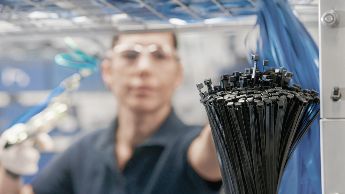eLearning: Cable ties and fixing solutions
Learn about cable tie and fixing material, tensile strength, manufacturing processes and storage.
What you get
- Discover how to bundle cables quickly and effectively, materials, and forces a tie or fixing needs to withstand
- Overview of ties and fixing elements
- Key features and uses of ties and fixings
►START ELEARNING
Why you should complete this training?
After you complete this training, you will have a good understanding of the following aspects:
- Three key questions that usually affect choices of ties and fixings
- Detailed descriptions of types of ties
- Overview of fixing elements
- Detailed insight into different types of fixing elements and when they are used
What you get
- Insight into materials and frequently used plastics
- Understanding of manufacturing processes
- How to store cable ties and fasteners made from polyamide
►START ELEARNING
Why you should complete this training?
After you complete this training, you will have a good understanding of the following aspects:
- Three common factors affecting choice of materials
- Frequently used plastics polyamides (PA), ethylene tetrafluoroethylene (E / TFE) and olyetheretherketone (PEEK)
- How to store polyamide products
What you get
- Basics of tensile strength in cable ties
- How to determine tensile strength
- Comparison of loop holding force with other force and weight unit
►START ELEARNING

Why you should complete this training?
After you complete this training, you will have a good understanding of the following aspects:
- Fundamental principles of tensile strength in cable ties (mounting options and materials are covered in other e-learning units)
- Testing tensile strength according to the US Military Standard experimental set-up
What you get
- Discover how moisture and hygroscopic properties affect flexibility
- Learn more about force, tensile strength and what this means for processing
- Tips, tools and storage that help you get the best results
►START ELEARNING
Why you should complete this training.
After you complete this training, you will have a good understanding of the following aspects:
- Hygroscopy and its implications for flexibility
- Force, tensile strength and how it is calculated
- How to adjust and tie, taking into account tensile strength and force
- How processing tools can help you
- Optimal storage
What you get
- Introduction to heat shrinkable products
- Advantages of the CHG900, how it works, and applications
- Comprehensive FAQs
►START ELEARNING
Why you should complete this training?
After you complete this training, you will have a good understanding of the following aspects:
- Heat shrinkable product use and general applications
- How the CHG900 cordless heat gun works
- Maintaining the cordless heat gun
- Applications in which you can use the CHG900
- Concludes with the opportunity to order the product and a set of 13 comprehensive FAQs.
Contact our experts
Are you interested in finding out more?
Our experts are always ready to offer help and advice, and answer any questions.





